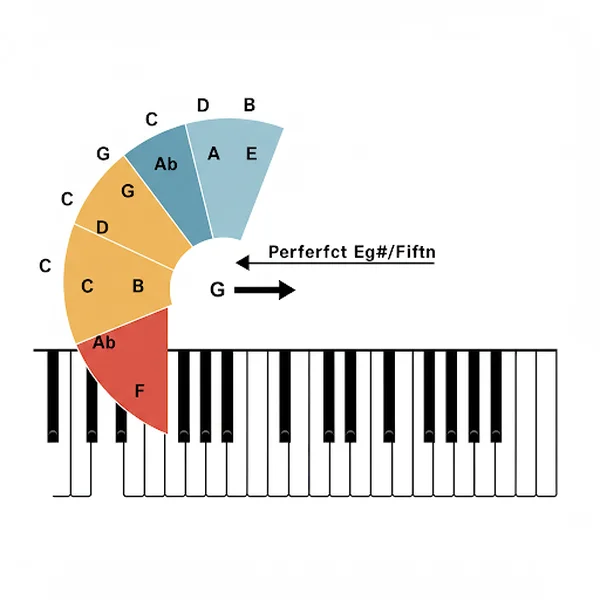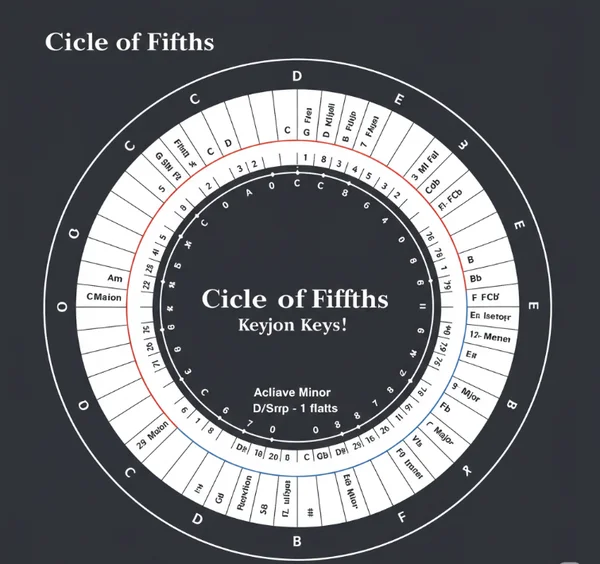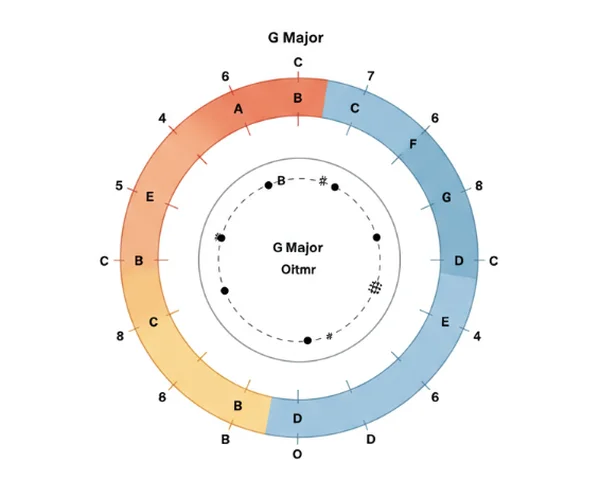Unlock Piano Skills: Circle of Fifths Guide for Scales & Chords
Are you a pianist looking to deepen your understanding of music theory and enhance your playing? Many pianists face challenges with systematically practicing scales, truly understanding chord relationships, or applying theory to improvisation. How can the circle of fifths improve my piano playing? This guide will illuminate how the circle of fifths piano connection is a powerful secret weapon for mastering piano chords scales, streamlining your piano practice theory, and unlocking new levels of musicality. Discover our interactive tool to see how it can help.
Understanding the Circle of Fifths on the Piano Keyboard
Before diving into specific piano applications, let's quickly recap what the Circle of Fifths is. It's a visual representation of the relationships between the twelve chromatic pitches, arranged in a sequence of perfect fifths. But how does this abstract diagram translate to the black and white keys in front of you?
Visualizing Key Relationships on the Keys
On the piano, moving up a perfect fifth from any note is straightforward (e.g., C to G, G to D). The Circle of Fifths simply organizes these relationships. This visualizing music theory directly on your keyboard helps you see how keys are related, making concepts like modulation and key signatures much more intuitive. You'll start to see patterns instead of just isolated notes, which is crucial for developing strong keyboard skills.

The Pattern of Fifths: Moving Up and Down the Keyboard
Understanding this pattern is fundamental. When you move clockwise on the Circle, you're moving up by a perfect fifth. When you move counter-clockwise, you're moving down a perfect fifth (or up a perfect fourth). Getting comfortable with finding these intervals quickly on the piano is a foundational step. This directly impacts your ability to navigate major minor keys piano relationships with ease.
Mastering Piano Scales & Arpeggios with the Circle of Fifths
What's the best way to practice scales on piano using the circle of fifths? The Circle of Fifths offers a logical and efficient way to tackle scales and arpeggios, moving beyond rote memorization.
Systematic Scale Practice: Following the Circle
Instead of practicing scales randomly or alphabetically, try practicing them by following the Circle of Fifths (e.g., C major, then G major, D major, and so on). This method ensures you cover all keys systematically and reinforces the relationship between them. This systematic approach to piano technique helps build muscle memory and theoretical understanding simultaneously.
Identifying Sharps and Flats for Each Scale Instantly
The Circle of Fifths brilliantly shows the order of sharps and flats. As you move clockwise (for sharp keys), each new key adds one sharp. As you move counter-clockwise (for flat keys), each new key adds one flat. This visual cue for key signatures piano is invaluable, saving you a lot of guesswork.

Building Arpeggios Based on Circle of Fifths Chords
Once you're comfortable with a key's scale, building its primary arpeggios (major and minor triads) becomes easier. The Circle helps you quickly identify the root notes of these chords within each key. Effective arpeggios practice often involves playing the arpeggio of the tonic chord in each key as you move around the Circle.
Effective Circle of Fifths Piano Exercises for Scales and Arpeggios
One great exercise is to play the major scale of a key, followed by its relative minor scale, then move to the next key on the Circle of Fifths and repeat. For arpeggios, try playing the I, IV, and V chords as arpeggios in each key. You can find more circle of fifths piano exercises and visualize these relationships with our interactive Circle of Fifths tool.
Demystifying Piano Chords Using the Circle of Fifths
How do I find chords on the piano with the circle of fifths? The Circle is a fantastic map for understanding and locating chords.
Finding Major and Minor Chords for Each Key
For any given key on the Circle, the notes immediately adjacent (clockwise and counter-clockwise) represent the dominant (V) and subdominant (IV) major chords, respectively. The relative minor (vi) is also easily found. This makes identifying the primary piano chords scales much faster.

Understanding Chord Relationships (e.g., I-IV-V) via the Circle
The proximity of these chords on the Circle visually reinforces their strong harmonic relationships. The I-IV-V progression, a cornerstone of Western music, is clearly laid out. This aids in understanding music theory in a practical way.
Exploring Chord Inversions with Circle of Fifths Logic
While the Circle itself doesn't directly show inversions, understanding the root notes of chords via the Circle provides a solid foundation. Once you know the root, finding inversions for different chord voicings piano becomes a more manageable next step.
Practical Circle of Fifths Piano Chords Voicings and Progressions
Try playing common progressions like ii-V-I in various keys by locating these chords on the Circle. For example, in C Major, Dm (ii) is related to G (V), which resolves to C (I). Experiment with different chord voicings piano as you get comfortable. See these progressions instantly with our online tool.
Enhancing Piano Practice Theory and Efficiency
Is the circle of fifths useful for piano practice theory? Absolutely. It transforms practice from a chore into a structured exploration.
Structuring Your Piano Practice Sessions with the Circle
You can dedicate practice sessions to specific "zones" of the Circle, focusing on a few related keys at a time. This brings a logical flow to your piano practice theory, ensuring comprehensive coverage without feeling overwhelmed.
Overcoming Common Practice Hurdles with Music Theory
Understanding why notes and chords fit together, as shown by the Circle, makes practice more engaging and less about blind repetition. This application of music theory for piano can significantly boost motivation and retention.
Using Our Tool for Interactive Piano Learning
Our interactive Circle of Fifths tool allows you to click on any key and instantly see its key signature, major/minor scales, and primary chords. This interactive learning piano experience can supercharge your practice sessions, making abstract concepts tangible.

Integrate the Circle of Fifths into Your Piano Journey
The circle of fifths piano relationship is a deep and rewarding one. By using it to understand scales, master chords, structure your practice, and guide your improvisations, you'll unlock significant improvements in your keyboard skills and overall musicianship. It’s more than just a diagram; it’s a practical tool for every pianist.
Ready to take your piano playing to the next level? We encourage you to explore these concepts further with the powerful interactive tool available here.
Circle of Fifths and Piano
-
How can the circle of fifths improve my piano playing?
The Circle of Fifths helps by providing a clear visual map of key relationships, making it easier to understand and memorize key signatures, scales (piano chords scales), and chord progressions. This structured understanding leads to more efficient practice and a deeper grasp of music theory for piano, ultimately improving your technique, sight-reading, and improvisation. Explore these relationships visually with our online helper.
-
What's the best way to practice scales on piano using the circle of fifths?
Practice scales by moving around the Circle clockwise (for sharp keys like G, D, A) or counter-clockwise (for flat keys like F, Bb, Eb). This ensures systematic coverage of all keys and reinforces the pattern of added sharps or flats. Incorporate relative minor scales as well for a complete workout. Many circle of fifths piano exercises follow this pattern.
-
How do I find chords on the piano with the circle of fifths?
For any key on the Circle, its tonic (I) chord is the starting point. The key to its right (clockwise) is the dominant (V) chord's root, and the key to its left (counter-clockwise) is the subdominant (IV) chord's root. The relative minor (vi) is also clearly indicated. Our online Circle of Fifths instantly shows these primary chords for any selected key.
-
Can the circle of fifths help with piano improvisation?
Yes, significantly! It helps you understand which notes and chords work well together within a key and how to move smoothly between related keys (modulation). It provides a framework for creating melodic lines and understanding harmonic movement, which are essential improvisation techniques piano.
-
Are there specific Circle of Fifths piano exercises for beginners available with your tool?
While our site is primarily an interactive visualization tool, the principles discussed here can be adapted into exercises. For beginners, focusing on playing the major scale and tonic chord of each key as you move around the Circle is a great start. The interactive tool itself allows you to see these scales and chords, aiding your piano practice theory.